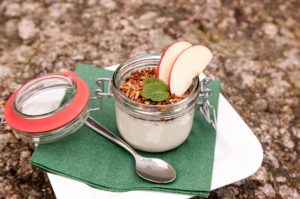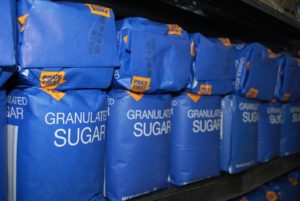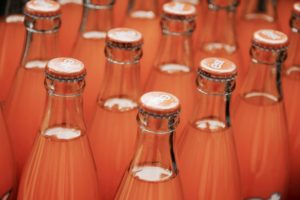Sugar: The large role it plays in our food supply.
Sugar is on my mind. Perhaps it is because San Francisco recently passed a new law stating that a health warning must be placed on all billboards in the city advertising sugar ladened foods and beverages, similar to the surgeon general’s warning placed on tobacco products. Or perhaps it is on my mind because we just returned from a trip to Disney World. The lemonade slushy, ice cream cones, strawberry syrup, chocolate chip croissants, bread pudding, milk shakes and apple crisp are now distant memories. Sweet memories though. I am likely going through sugar withdrawal, but that is o.k. Vacations are designed for doing things differently and taking a break from the normal routine. On this trip, my daughter learned that ice cream can really be a main course for dinner, but only on vacation. Throughout the week, everywhere we turned, sugar was plentiful. It was a vivid reminder how it has invaded our food. America is hooked on sugar, and unfortunately many people ingest way more than they are aware. Added dietary sugar is now linked to chronic inflammation, obesity, increased “belly fat”, insulin resistance, increased risk of atherosclerosis, heart disease, diabetes, cancer, alteration of our bodies natural satiety hormones, decreased energy levels, and other chronic illnesses. The American Diabetes Association reports that someone is diagnosed with Type II diabetes every 20 seconds in this country. Wow!! The financial costs of chronic illnesses continue to skyrocket while industry hides more sugar in their products and works extra hard to convince the public that added sugar is not contributing to the declining health of this nation.

How is your sugar I.Q.? Picture this daily menu…
Breakfast:
Glass of orange juice (Minute Maid 100% juice 8 oz.)
Bowl of oatmeal (the real stuff cooked on the stove) topped with two teaspoons brown sugar, 1/8 cup dried cranberries (14.5 g), 1/2 banana
One cup (8 oz) coffee with 1 Tablespoon CoffeeMate Natural Bliss Vanilla Creamer
Lunch:
One container of strawberry Yoplait yogurt (170 grams, 6 oz)
Peanut butter and Jelly sandwich made with two slices of store bought wheat bread, 1 Tablespoon of fruit jam, 2 Tablespoons of Laura Scudders Old Fashioned Peanut Butter
Apple
One bottle of Snapple Lemon Tea (16 oz)
Sound healthy? No boxed cereal. No muffins. No dessert. No soda. No candy. Unfortunately, this unsuspecting person, trying to eat healthy, has just ingested a whopping 90.5 grams of added sugar (with room for slight variation depending on the exact variety), even before an afternoon snack or dinner. Poor unsuspecting consumer, trying to make good decisions. (If you were trying to guess, the yogurt, cranberries and the Snapple added the greatest amounts of added sugar to our fictitious diet, 62.6 grams.)

Sugar. It is sweet, delicious and everywhere. Before I plunge ahead, I must discuss the differences between two classes of sugar. It can be classified as either “natural” or “added”. Natural is natural. It is found naturally in foods such as fruits, vegetables and milk. It is not added through any food processing. Added sugars are defined as any type added to a food during processing or added to foods at the table. When reading a food label, you may see white, brown, agave, raw, corn syrup, high fructose corn syrup, corn syrup solids, malt syrup, maple syrup, fructose sweetener, liquid fructose or crystal dextrose. They are all forms of added sugar in our foods. Although added sugar is not chemically different from naturally occurring sugar, it is more problematic, for it is found in greater amounts than its natural form. You will need to eat 40 kiwis to consume the same amount of sugar as in one can of Coke. Added sugar is also problematic because it is often found in foods with lower nutritional value, no fiber and no essential nutrients. Foods with added sugar generally do not have the high fiber content of fruits and vegetables. This high fiber content helps to slow the absorption of sugar. Although our unsuspecting consumer drank 100% natural orange juice without any added sugar, juicing strips the fruit of it’s natural fiber, thus resulting in a faster spike in blood sugar. Unfortunately, manufacturers are not required to disclose on food labels specifically how much added sugar is in their products. Manufacturers only list total sugar, which is a combination of both natural and added sugar .
If you spend some time reading labels, you will find sugar in dozens of products, many of which you would least expect. Why does bread have 5 grams per slice? Why does a half cup of a traditional spaghetti sauce have about as much sugar as two Girl Scout Thin Mint Cookies? When did yogurt turn into such a sweet treat with a container of Yoplait containing more sugar than a cup of Lucky Charms? How did added sugar find such a solid, comfortable home in our food? Let’s start with some history.

Decades ago, before the advent of processed food, people ate real food. All ingredients were recognizable, and much time was spent in the kitchen. In the 1950’s, in an effort to convince the housewife that things in the kitchen could be easier and to provide convenience, industry created processed, prepackaged foods, loaded with sugar, salt and fat. Sugar was added to make processed food more palatable, but it also extended the shelf life of products by inhibiting the growth of bacteria. Cane and beet sugar were the two main sources of sugar until the 1970’s. Due to the increasing cost, high fructose corn sugar (HFCS) was invented. Industry loved HFCS. It was cheaper than cane and beet sugar, and it could be added directly into products because it was a liquid. The use of HFCS began to skyrocket. The federal government unfortunately helped to pump HFCS into our diets by subsidizing corn and keeping the price of corn syrup low. The invention of HFCS was a win for food manufacturers and corn farmers, but a loss to consumers in regards to health and the quality of our food. Soda manufacturers, in particular, capitalized on the use of HFCS. In Michael Moss’s book, “Sugar, Fat, Salt” (2013) he describes the history of the soda industry and how between 1970 and 2000, America’s consumption of soda grew to 40 gallons a year per person. With a can of Coke containing 9 teaspoons of sugar and a 7-11 Double Gulp of Coke containing 44 teaspoons of sugar, it is easy to see how added sugar was easily bombarding the typical American diet. America’s consumption of soda did decrease to 32 gallons per year per person in 2011, but unfortunately this decline occurred with a simultaneous increase in the consumption of sugary beverages, including sports drinks, sweet teas and vitamin waters. Americans are now swapping one sugary drink for another. I can’t but help read theses statistics and wonder…what is so wrong with water?
Another shift in nutritional views in the 1990’s resulted in more added sugar pumped into our food. Nutritionists and the government warned of the dangers of fat consumption. Fat became the enemy, and manufacturers responded by removing much of the fat in their products and simultaneously increasing the sugar content to enhance flavor. Americans heeded the warnings regarding the dangers of fat and started to buy no fat and low fat products. However, Americans were naively consuming more and more added sugar.
Industry holds some blame for the amount of sugar Americans are consuming. Processed, packaged foods high in sugar, salt and fat are in many cases cheaper than “real” food. Advertising has also led many to believe they are eating healthier than they truly are. However, our bodies natural physiology also plays a part in our enjoyment of sugar and thus high consumption.
Our bodies are designed to love sweets. In every one of the mouth’s taste buds, there are special receptors designed to detect sweetness. The map of the tongue we all remember from biology class is wrong. Tastes are not located in specific regions of the tongue as once was thought. All taste qualities (sweet, salty, bitter, sour, unami) are perceived all over the tongue. As Gina Willet notes in her book, “Sugar, Salt, & Fat”, (2015) sugar receptors are now also being discovered in the esophagus, stomach and pancreas. Our appetite for sugar is being further enhanced after the food leaves our mouth due to sweet receptors in other areas of the gastrointestinal tract.

Once we consume a sugary food, dopamine is released in the brain. Dopamine is a chemical released by the brain in response to pleasure. Release of dopamine occurs when something feels good and is pleasurable, such as listening to a favorite song, enjoying a beautiful sunset or having sex. The surge of dopamine stimulates another part of the brain, the brain’s pleasure center, which is then ultimately responsible for magnifying the perceived amount of pleasure. Sugar stimulates the brains “sweet spot” literally, just as a nice hug, good conversation or taking illicit drugs does. The more sugar we ingest, the greater the release of dopamine and the more intense the experience of pleasure. This natural brain circuitry was designed for procreation and survival. It was not designed to be stimulated by added sugar in our diet and illicit drugs. This circuitry accounts for the addictive nature of sugar, why we often turn to a sweet treat to help us “feel good”, and why ice cream truly does make us feel happy. In Michel Moss’s book noted above, he describes a study in which vanilla ice cream was fed to college students while receiving MRI scans of their brain. Ingesting the ice cream caused an immediate surge in dopamine, and the brain’s pleasure centers immediately lit up. This same brain circuitry is involved with the addiction to illicit drugs.
Over time, as we continue to eat more and more added sugar in our diet, the brain’s pleasure center becomes overloaded and overworked, resulting in a reduced sensitivity to dopamine. The brains’s natural circuitry is altered, resulting in a desire for more sugar to achieve a prior level of pleasure. This explains why nobody eats a true serving of ice cream (1/2 cup), “supersizing” is now part of our daily vocabulary, and why we truly “can’t eat just one” of anything.
So in today’s society where sugar bombards us everywhere, it is hidden in so many products, our brain is wired to love it, and manufacturers are continually trying new tricks to increase our sugar consumption, what is a health conscious consumer to do? Reduce your added sugar intake. Simple advice but truly not easy to do. If you are concerned about your health today and your health tomorrow, you owe it to yourself to reduce your intake of added sugar. Start by taking a serious look at your diet, get out your calculator and think honestly about how much added sugar you are consuming on an average day. You will likely be surprised. Read labels. Visit www.nutrition.gov for nutrition profiles of most foods. Compare your added sugar totals to those recommended by the World Health Organization (WHO):
For an average adult, limit added sugar to 6-9 teaspoons (25 grams – 36 grams) per day.
Take small steps to reduce your added sugar intake, and you will likely feel better. Try it. If my husband can be convinced to change his diet, anyone can. Education is the first step. It is your responsibility to take the second.


Excellent article, thoroughly researched and full of practical information. Thank you for bringing this topic to my attention. Your sample diet really tells the story. Frightening to imagine what the math is for those who eat fast foods, donuts, etc. regularly or feed those things to their children. Your article has inspired me to commit to doing a better job reading labels. My favorite weight loss App does not account for amount of sugar in food as I enter what I eat throughout the day. I will have to track that separately. Any suggestions for lower sugar brands or types of yogurt? I had heard full fat yogurt has less added sugars. I wonder if that is true. Thank you again!
Thanks for the comments. It is unbelievable and sad to imagine all the hidden added sugar in fast food and packaged foods. The FDA just mandated new food labels which will list added sugar amounts. Hopefully this will help the consumer. However, they are sadly being guided by the food manufacturers and recommending added sugars be limited to 50 grams a day, way higher than the World Health Organization recommends. They are missing the mark again, and the unknowing consumer trying to make good choices will suffer. As far as yogurt, any plain yogurt does not have added sugar. They only sugar in plain yogurt comes from the natural lactose in milk. If you eat plain yogurt and top it with your own fruit, nuts, seeds, you are not adding any added sugar to your day. You will only get the sugar found naturally in the milk and fruit. When buying plain yogurt, the label should read milk and added cultures. Look for 6 added cultures for optimum probiotic benefit. Stoneyfield is a good choice. In general, as the fat content of milk is reduced, some of the natural lactose is removed, so lower fat milks have less natural sugar. Greek yogurt has less natural sugar than regular yogurt, as the whey is strained out. Good luck with your yogurt search!
Great information! I guess I will add reading labels and checking my sugar intake to my list of summer projects. Thanks Maureen.
This is very informative. It is no wonder why the US obesity rates are growing. We are battling against a corporate mentality of profit before anything. Staying educated is the only way to beat the manipulation of greedy business. Well done!